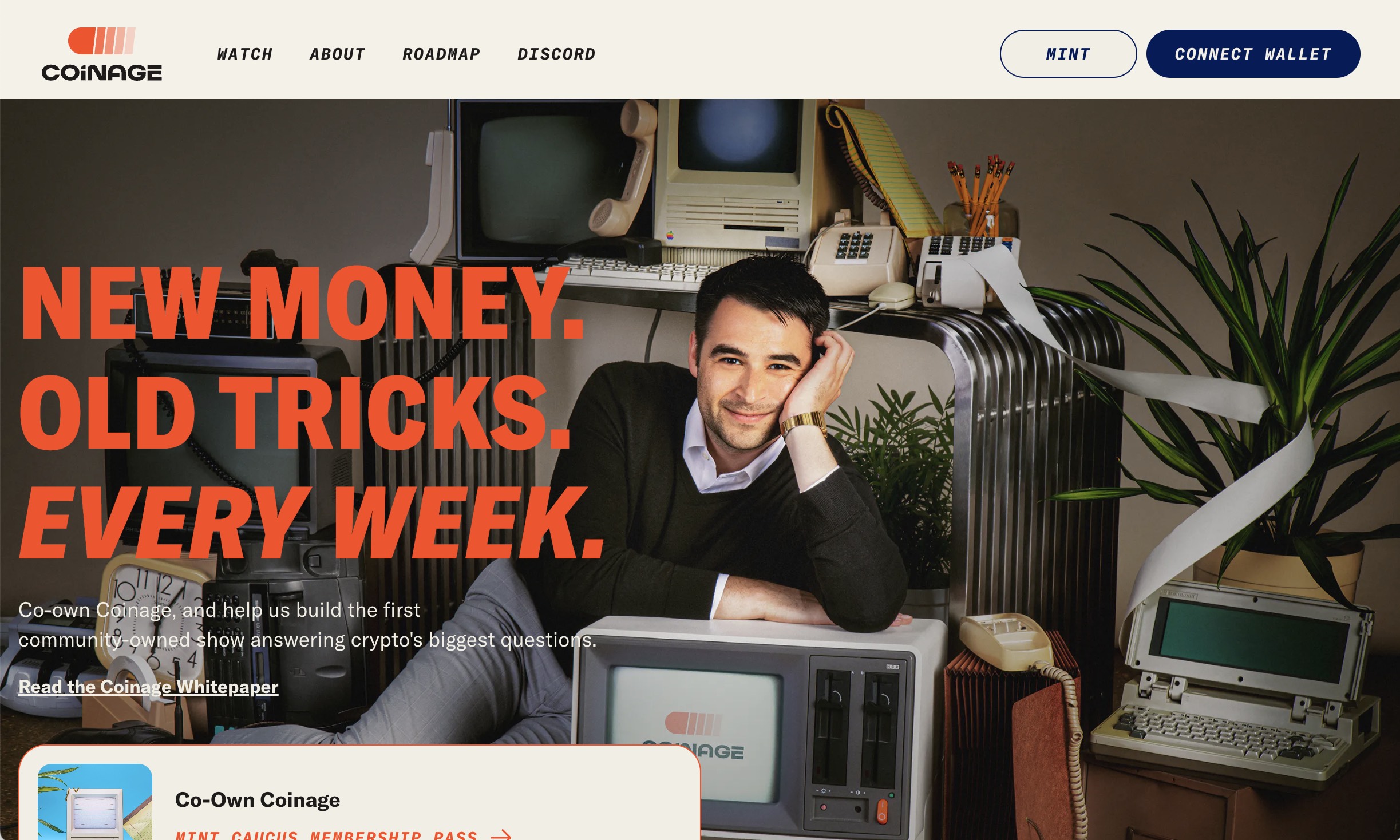Remember when
The worst form of design
April 2, 2023
I’m mid-life now, which means I’ve lived long enough to see the trends from my formative years, the 90’s, come back in fashion. When it comes to literal fashion—Friends sweatshirts, baggier jeans and so forth—that feels charming and regular. But when it comes to digital fashion, that feels weird and bad.
Consider the return of Chicago font, 8-bit artwork and terms like Web3. Maybe I’m overthinking this; maybe the return of Chicago and 8-bit in digital design is just another instance of fashion being an eternal remix. But there’s an obvious difference between fashion and products—fashion is just how we adorn ourselves, while digital products should always point to a new and better future. It’s really problematic if the ethos of digital product design is that we need to restore things to the way things once were.
Some examples of retro design:
 In the absence of a new idea, Coinage recreated an old Bill Gates photoshoot
In the absence of a new idea, Coinage recreated an old Bill Gates photoshoot

 In the absence of a new idea, SeedClub merely lifted Apple’s original OS styles
In the absence of a new idea, SeedClub merely lifted Apple’s original OS styles
 In the absence of a new design motif, Cryptopunks appeals to the nostalgia of early gaming
In the absence of a new design motif, Cryptopunks appeals to the nostalgia of early gaming
 In the absence of a modern spin on radio, Poolsuite just cribs the Apple II OS design
In the absence of a modern spin on radio, Poolsuite just cribs the Apple II OS design
 Vacation sunscreen, a reminder that in spite of all the grunge and Prozac, the 90’s were more carefree
Vacation sunscreen, a reminder that in spite of all the grunge and Prozac, the 90’s were more carefree
(Aside: Forgive me if you had a hand in designing any of the above. If your response is, "Wow this dude has gotten cranky in middle age," you'd be right.)
And then you’ve got the mother of all Remember When’s: the term “Web3”
 The term “crypto” was too original, so out of impatience for traction we switched to something more familiar
The term “crypto” was too original, so out of impatience for traction we switched to something more familiar
The pervasion of the term Web3 is sort of forgivable if it merely helps to complete the Read (Web1) => Write (Web2) => Own (Web3) gestalt. But it’s really lame inasmuch as it was pushed top-down by folks with lots of things to sell, similar to "Metaverse". At the peak of Metaverse/Web3 it really felt like the 90’s, when PepsiCo was pushing Pepsi as "the choice of a new generation", except instead of approaching it with an alright-look-I’ll-at-least-try-it attitude that befits corporate marketing, we interpreted Metaverse/Web3 as a bottom-up phenomenon.
And then there’s the most sinister reason for the use of Web3, Chicago font, and 8-bit art: It’s an appeal to a time when lots of optimistic, technical- and design-minded people had very wealthy futures in store. It presupposes that there’s a new, lucrative increment of Web_ every 10 years as reliably as Moore’s Law predicts the shrinking of circuits.
It's worse than that
— Jonathan Libov (@libovness) January 17, 2023
Implicit in "web3" is the message that "you missed the lucrative boat of web2 but don't worry there's another lucrative boat embarking now". Which is partly why web3 often feels brute-forced and certainly why nostalgia is the primary aesthetic in crypto
This captures a sentiment I’ve felt. I want there to be a next big thing in software and to live 2010s again. But there doesn’t always have to be one. And the more I learn about fascinating things are going on in other fields, the more bored I am listening to other sw guys. https://t.co/hncDpxuWaj
— Dan Grover (@DanGrover) December 24, 2021
For as little as I’ve followed ChatGPT, Midjourney and other AI products—I run a non-AI startup and have two kids at home that occupy all of my time—it’s refreshing to see that its proliferation has required zero marketing, just product. And that feels much more like the halcyon days of Web1 and Web2 more than Web3 and its accouterments ever have.
Crypto, as I prefer to call it, is in fact a bottoms-up phenomenon, but in my estimation real crypto stuff requires the kind of patience that only people who couldn’t bear to work on anything else would have. The Homebrew Computer Club, after all, wasn’t guaranteed a generation of wealth. If crypto is—still very plausibly—10 years away from mainstream use, how many people and investors really have the stomach to wait that long?
Appealing to the aesthetics of that era is like marketing a risk-free path to prosperity: A movement that relies on hindsight more so than foresight, an industry that will welcome your community-building skills if you don’t have any technical skills, and a mutiny against the fiat system that is somehow supposed to be sanctioned by US authorities. If you’re swayed by this aesthetic, it may be a sign you’re eager to be swayed. (Which honestly is totally fine if you’re buying sunscreen).
As Tony Soprano put it, "'Remember When' is the lowest form of conversation". Which is to say, things that are the future should really look like the future, not the past, and as Tony found out himself, that’s difficult.
